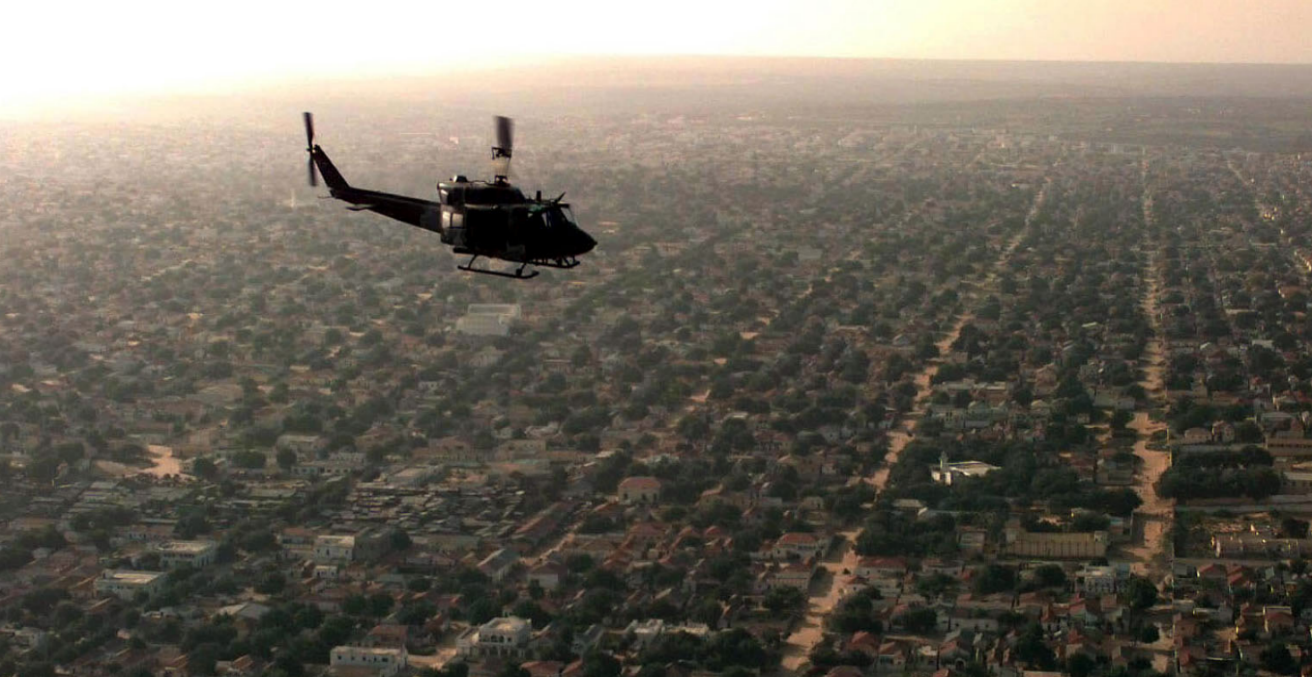Saving US Soldiers or Enemy Civilians?

Twenty-five years after Black Hawk Down, the trade-off between casualty-aversion and civilian protection continues to trouble US warfare.
On 3-4 October 1993, two US Black Hawk helicopters were shot down in the Somali capital Mogadishu. Eighteen US soldiers were killed and the sight of dead US soldiers being dragged through the streets of Mogadishu caused outrage. Within six months, the US had withdrawn its forces from Somalia. Its effect is still being seen in US military behaviour.
Operation Restore Hope
Two days prior to the highly-televised amphibious landing of 28,000 US soldiers on the beaches of Mogadishu in December 1992, the head of the United States’ Operation Restore Hope secretly met with Somali warlord Mohamed Farah Aideed. The purpose of this clandestine mission was to reassure Aideed that US forces were to be deployed purely on humanitarian grounds – to stop a devastating famine – and not to interfere into the brutal civil war that was engulfing the Horn of Africa at the time.
While Aideed accepted the reassurances, he nevertheless issued a stark warning to US Special Envoy Robert Oakley:
“I have studied the lessons of your wars in Vietnam and Lebanon. If you move away from your proclaimed humanitarian objectives, I know how to get rid of you by killing a handful of your soldiers and by provoking you to kill excessive amounts of our civilians.”
The reluctance on part of the United States to risk the lives of its soldiers and the legal need to spare innocent Somali civilians were understood by Aideed as the centre of gravity of US warfare.
In May 1993, when US policies under the incoming Clinton Administration shifted to peace enforcement, the notorious warlord stuck to his words. In the ensuing conflict, his asymmetric guerrilla strategy generated a local security environment that no longer allowed US commanders to wage their hunt for Aideed in line with the norms of casualty-aversion (the perceived need to wage war with little if not zero risks to US soldiers) and civilian protection (the legal need for the US to use force in a restrained and discriminatory manner).
Confronted with this dilemma, US leaders were forced to choose between protecting the lives of their own soldiers and those of innocent Somali civilians. They decided to prioritise their concerns for the lives of US soldiers. This change in US operations resulted in mounting numbers of civilian casualties, a dramatic growth in popular support for Aideed and, ultimately, the disastrous Black Hawk Down incidents that triggered US withdrawal.
Asymmetric wars
Over the next two and a half decades, conflicts involving US forces were of similar asymmetric nature. Somalia thus constituted not only the first in a series of similar combat experiences for the US. It also provided a blue print for how militarily-disadvantaged non-state actors could defeat the world’s most powerful military machinery by creatively employing asymmetric strategies, strategies which deliberately aimed at exploiting the two core areas of vulnerability within US warfare: casualty-aversion and civilian protection.
In that sense, Somalia confronted the US military with challenges that have become all too familiar since: a nebulous non-state adversary which is willing to sacrifice large numbers of its own troops to kill a handful of US soldiers, which hides in Mosques, hospitals and densely-populated areas, which uses human shields and which tries to provoke US forces to cause large number of civilian casualties. Where Aideed had previously proclaimed that he had learned the lessons of Vietnam and Lebanon, subsequent US adversaries from Bin Laden to Mullah Omar, from Al Zarqawi to al-Baghdadi, all stated that they had learned the lessons of Vietnam, Lebanon and Mogadishu.
US adversaries have repeatedly forced the US to choose between saving its own soldiers and safeguarding innocent civilians. And US decision-makers have tended to prioritise the lives of US soldiers over the lives of civilians, transferring the risks of combat with the most immediate consequence being a rise in the number of civilian casualties.
Law, morality and strategy
From a legal perspective, the ways in which the US military has transferred combat risks from its soldiers to enemy civilians did not – with a handful of exceptions – violate the laws of war. This might come as a surprise as the laws of war do constrain military action to spare the lives of innocent civilians from direct and deliberate attacks. However, the laws of war are permissive with regards to the infliction of collateral damage (that is, unintended, indirect yet foreseeable civilian deaths) and remain silent on the question of how much additional risk soldiers are required to take to reduce the risks faced by civilians.
While it might be legal, inflicting collateral damage remains a sensitive moral issue precisely because civilians are entitled to something more, namely that due care is taken with their lives. From this moral perspective, soldiers are obliged to accept higher risks to themselves (within limits) if this leads to a reduction of the risks faced by civilians. Extensive empirical analysis of US operations in Somalia, Kosovo, Afghanistan and Iraq have shown that marginal increases in the risks to US soldiers could have saved significantly larger numbers of innocent civilians. Yet instead US forces operated in such a casualty-averse manner that it maximised rather than minimised non-combatant risks.
The failure of the US military to meet moral requirements around civilian protection matters not just from a humanitarian perspective, but also strategically. Low levels of civilian protection have led to a loss of hearts and minds among the enemy population, thereby causing the US military to fail in the pursuit of its military objectives in Somalia, Kosovo, Afghanistan and Iraq.
What this shows is that formal compliance with the laws of war might not be enough to win the asymmetric wars of the twenty-first century. Instead, there is now a strategic need for the US to adhere to stricter moral guidelines to protect innocent civilians, even if this means accepting a marginal increase in the combat risks faced by US soldiers. Whether such a rebalancing will occur, time will tell. The message, however, is clear: unless it does, strategic losses and inconclusive conflicts – like those experienced in Somalia and subsequently – are more likely to reappear in the future.
Dr Sebastian Kaempf is Senior Lecturer in Peace and Conflict Studies at The University of Queensland.
This article is based on his presentation at AIIA Queensland on 11 September 2018.
His new book ‘Saving Soldiers or Civilians: Casualty-Aversion versus Civilian Protection in Asymmetric Conflicts’ was published by Cambridge University Press in 2018. A 20 per cent discount on his book is available by using the code KAEMPF2018 at the checkout.
This article is published under a Creative Commons Licence and may be republished with attribution.





